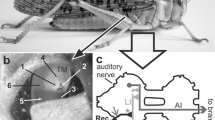Summary
-
1.
The receptor potential (RP) which occurs at the level of tuberous organs in the mormyrid fish (Gnathonemus petersii andG. stanleyanus) was investigated using simultaneous thermal and electrical stimuli (Part I). Its functional relationship to the propagated potential (PP) in the afferent nerve fiber was analysed (Part II).
-
2.
Two types of spontaneously occurring potentials were recorded extracellularly at the level of these organs: 1) small (100 μV) slow potentials of variable amplitude and 2) large (several mV) diphasic initially positive spike-like potentials (RP) with constant amplitude and duration. The behaviour of the two types of potential to thermal and electrical stimuli indicates that the slow potential is the generator potential of the RP.
-
3.
The spontaneous as well as the electrically provoked RP obeys the “all or none” law. In contrast, the RP as well as its generator potential, both are graduable with combined electrical and thermal stimuli.
-
4.
The amplitude of the RP diminishes with decreasing temperature, whereas its duration remains constant. Tested with paired electrical stimuli, the RP does not show any unresponsive period; also, the RP can be driven by repetitive stimulation to several thousands cycles/s. Thus, the RP does not show the characteristics of a nerve-spike.
-
5.
Simultaneous recordings of RP and correlated propagated potentials (PP) show that the RP is a local phenomenon arising at the sensory cell membrane.
-
6.
Without being the generator potential, the RP is indispensable for the advent of the nerve impulse; the RP and PP are strictly phase related.
-
7.
The generation of the nerve impulse is not related to the amplitude of the RP.
-
8.
Considering the morphological features of the junction between the sensory cells and the afferent nerve fiber, it is suggested that the RP provokes the release of transmitter substances present in the presynaptic area, which in turn depolarizes the post-junctional membrane.
Similar content being viewed by others
References
Barets, A., Szabo, T.: Appareil synaptique des cellules sensorielles de l'ampoule de Lorenzini chez la Torpille,Torpedo marmorata. J. Microscopie (Paris)1, 47–54 (1962).
Bennett, M. V. L.: Electroreceptors in mormyrids. Cold Spr. Harb. Symp. quant. Biol.30, 245–262 (1965).
Bennett, M. V. L.: Mechanisms of electroreception. In: Lateral line detectors (ed. P. Cahn), p. 313–393. Bloomington: Indiana Univ. Press, 1967.
Davis, H.: Some principles of sensory receptor action. Physiol. Rev.41, 391–416 (1961).
Davis, H.: A model of transducer action in the cochlea. In: Cold Spr. Harb. Symp. quant. Biol.30, 181–190 (1965).
Derbin, C., Denizot, J. P., Szabo, T.: II. Ultrastructure of the type B sense organ of the specific lateral line system ofGymnarchus niloticus. Z. Zellforsch.98, 262–276 (1969).
Derbin, C., Szabo, T.: L'ultrastructure des cellules sensorielles et des cellules accessoires du ≪Knollenorgan≫ d'un Mormyridé,Gnathonemus petersii. C. R. Acad. Sci. (Paris)265, 1211–1214 (1967).
Derbin, C., Szabo, T.: Ultrastructure of an electroreceptor (Knollenorgan) in the mormyrid fish,Gnathonemus petersii. J. Ultrastruct. Res.22, 469–484 (1968).
Fessard, A., Szabo, T.: Mise en évidence d'un récepteur sensible à l'électricité dans la peau des mormyres. C. R. Acad. Sci. (Paris)253, 1859–1860 (1961).
Fessard, A., Szabo, T.: Effets des variations de température sur l'activité de certains récepteurs des mormyres. C. R. Acad. Sci. (Paris)254, 2084–2085 (1962).
Fex, F.: Auditory activity in centrifugal and centripetal cochlear fibers in cat; a study of a feed-back system. Acta physiol. scand.55, 189 (1962).
Flock, Å.: Transducing mechanisms in the lateral line canal organs receptors. In: Cold Spr. Harb. Symp. quant. Biol.30, 133–145 (1965).
Furukawa, T., Ishii, Y.: Neurophysiological studies on hearing in goldfish. J. Neurophysiol.30, 1377–1403 (1967).
Gerard, P.: Sur les appareils sensoriels de la peau deMormyrus caballus (Blyr). Bull. Inst. roy. Col. Belge11, 212–226 (1940).
Hodgkin, A. L., Katz, B.: The effect of temperature of the electrical activity of the giant axon of the squid. J. Physiol. (Lond.)109, 240–249 (1949).
Moller, P., Bauer, R.: Communication in weakly electric fish,Gnathonemus petersii (Mormyridae). II. Interactions of electric organ discharge of two fish. (Submitted.)
Mullinger, A. M.: The fine structure of ampullary electric receptors inAmiurus. Proc. roy. Soc. B160, 345–359 (1964).
Murray, R. W.: The responses of the ampullae of Lorenzini to combined stimulation by temperature change and weak direct currents. J. Physiol. (Lond.)145, 1–13 (1959).
Payton, B. W., Bennett, M. V. L.: Cooling increases junctional resistance at an electronic synapse. Biophys. J.9, A 63 (1969).
Roth, A., Szabo, T.: The effect of sensory nerve transsection on the sensory cells and on the receptor potential of the tuberous (Knollen) organ in Mormyrid fish (Gnathonemus sp.). Z. vergl. Physiol.62, 395–410 (1969).
Roth, A., Szabo, T.: Qualitative analysis of the effect of thermal stimuli on the spontaneous activity of tuberous (Knollen) organs inGnathonemus sp. Mormyridae, Pisces. J. exp. Biol.52, 707–719 (1970).
Szabo, T.: Spontaneous electrical activity of cutaneous receptors in Mormyrids. Nature (Lond.)194, 600–601 (1962).
Szabo, T.: Sense organs of the lateral line systems in some electric fish of the Gymnotidae, Mormyridae and Gymnarchidae. J. Morph.117, 229–250 (1965).
Szabo, T., Bauer, R., Moller, P.: Elektrische Sinneswahrnehmungen und Verhalten elektrischer Fische. Naturwissenschaften. (In press.)
Szabo, T., Fessard, A.: Le fonctionnement des électrorécepteurs chez les Mormyridés. J. Physiol. (Lond.)57, 343–360 (1965).
Szabo, T., Both, A.: Comportement des potentiels propagés dépendant de la modulation des potentiels récepteurs autoactifs des ≪Knollenorgane≫. C. R. Acad. Sci. (Paris)265, 807–809 (1967).
Wachtel, A. W., Szamier, B. R.: Special cutaneous receptor organs of fish: the tuberous organs ofEigenmannia. J. Morph.119, 51–80 (1966).
Wersäll, J.: Studies on the structure and innervation of the sensory epithelium of the cristae ampullares in the Guinea Pig. Acta oto-laryng. Suppl.126 (1956).
Author information
Authors and Affiliations
Rights and permissions
About this article
Cite this article
Roth, A., Szabo, T. The receptor potential and its functional relationship to the nerve impulse analysed in a sense organ by means of thermal and electrical stimuli. J. Comp. Physiol. 80, 285–308 (1972). https://doi.org/10.1007/BF00694842
Received:
Issue Date:
DOI: https://doi.org/10.1007/BF00694842




